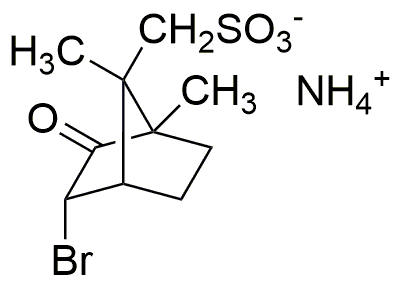(+)-3-Bromocamphor-8-sulfonic acid ammonium salt is widely utilized in research focused on:
- Chiral Catalysis: This compound serves as a chiral auxiliary in asymmetric synthesis, enabling the production of enantiomerically pure compounds, which is crucial in pharmaceuticals.
- Biochemical Studies: It is used in the study of enzyme mechanisms and interactions, helping researchers understand biological processes and develop new drugs.
- Organic Synthesis: This chemical acts as a reagent in various organic reactions, providing a reliable method for synthesizing complex molecules in the chemical industry.
- Analytical Chemistry: It is employed in chromatography as a stationary phase modifier, enhancing the separation of compounds in complex mixtures.
- Material Science: The compound is explored for its potential in developing new materials with specific properties, such as improved thermal stability and solubility.
General Information
Properties
Safety and Regulations
Applications
(+)-3-Bromocamphor-8-sulfonic acid ammonium salt is widely utilized in research focused on:
- Chiral Catalysis: This compound serves as a chiral auxiliary in asymmetric synthesis, enabling the production of enantiomerically pure compounds, which is crucial in pharmaceuticals.
- Biochemical Studies: It is used in the study of enzyme mechanisms and interactions, helping researchers understand biological processes and develop new drugs.
- Organic Synthesis: This chemical acts as a reagent in various organic reactions, providing a reliable method for synthesizing complex molecules in the chemical industry.
- Analytical Chemistry: It is employed in chromatography as a stationary phase modifier, enhancing the separation of compounds in complex mixtures.
- Material Science: The compound is explored for its potential in developing new materials with specific properties, such as improved thermal stability and solubility.
Documents
Safety Data Sheets (SDS)
The SDS provides comprehensive safety information on handling, storage, and disposal of the product.
Product Specification (PS)
The PS provides a comprehensive breakdown of the product’s properties, including chemical composition, physical state, purity, and storage requirements. It also details acceptable quality ranges and the product's intended applications.
Certificates of Analysis (COA)
Search for Certificates of Analysis (COA) by entering the products Lot Number. Lot and Batch Numbers can be found on a product’s label following the words ‘Lot’ or ‘Batch’.
Numéro de catalogue
Numéro de lot/série
Certificates Of Origin (COO)
This COO confirms the country where the product was manufactured, and also details the materials and components used in it and whether it is derived from natural, synthetic, or other specific sources. This certificate may be required for customs, trade, and regulatory compliance.
Numéro de catalogue
Numéro de lot/série
Safety Data Sheets (SDS)
The SDS provides comprehensive safety information on handling, storage, and disposal of the product.
DownloadProduct Specification (PS)
The PS provides a comprehensive breakdown of the product’s properties, including chemical composition, physical state, purity, and storage requirements. It also details acceptable quality ranges and the product's intended applications.
DownloadCertificates of Analysis (COA)
Search for Certificates of Analysis (COA) by entering the products Lot Number. Lot and Batch Numbers can be found on a product’s label following the words ‘Lot’ or ‘Batch’.
Numéro de catalogue
Numéro de lot/série
Certificates Of Origin (COO)
This COO confirms the country where the product was manufactured, and also details the materials and components used in it and whether it is derived from natural, synthetic, or other specific sources. This certificate may be required for customs, trade, and regulatory compliance.


